INF30003: Business Information System Analysis Report - SPT Case Study
VerifiedAdded on 2022/09/09
|9
|2849
|45
Report
AI Summary
This report provides a detailed analysis of a Business Information System (BIS) case study, focusing on Swim Public Transport (SPT). The report identifies key problems faced by SPT, including driver turnover and the need for a Virtual Reality (VR) system for training. It explores soft and hard system problems, analyzes key stakeholders, and utilizes tools and techniques such as design thinking to propose solutions. The analysis includes a rich picture representation of SPT's business processes and concludes with recommendations for implementing a VR system and improving driver retention policies. The report emphasizes the importance of technology and innovation in addressing business challenges and improving overall efficiency within the organization.
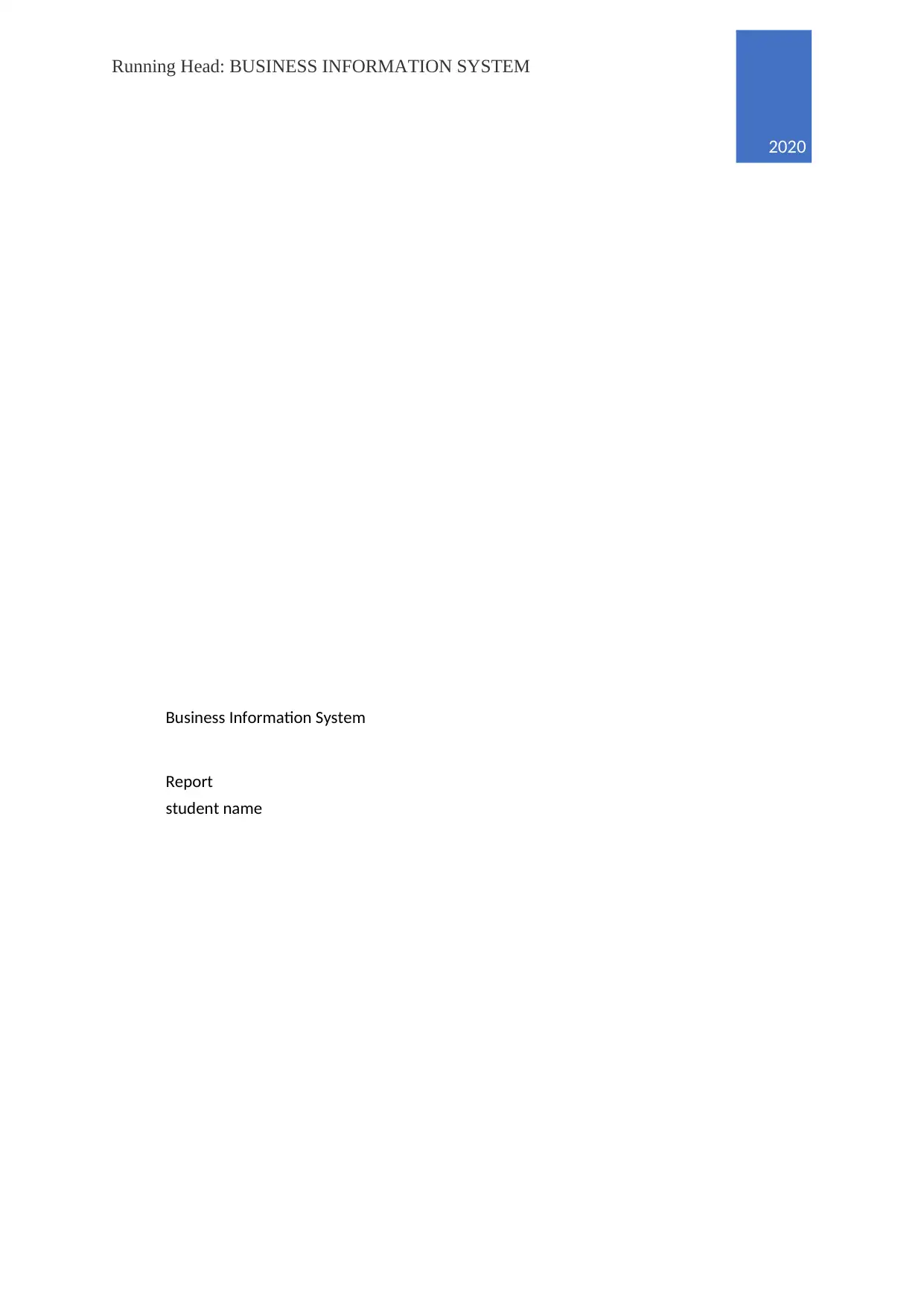
Running Head: BUSINESS INFORMATION SYSTEM 0
2020
Business Information System
Report
student name
2020
Business Information System
Report
student name
Paraphrase This Document
Need a fresh take? Get an instant paraphrase of this document with our AI Paraphraser
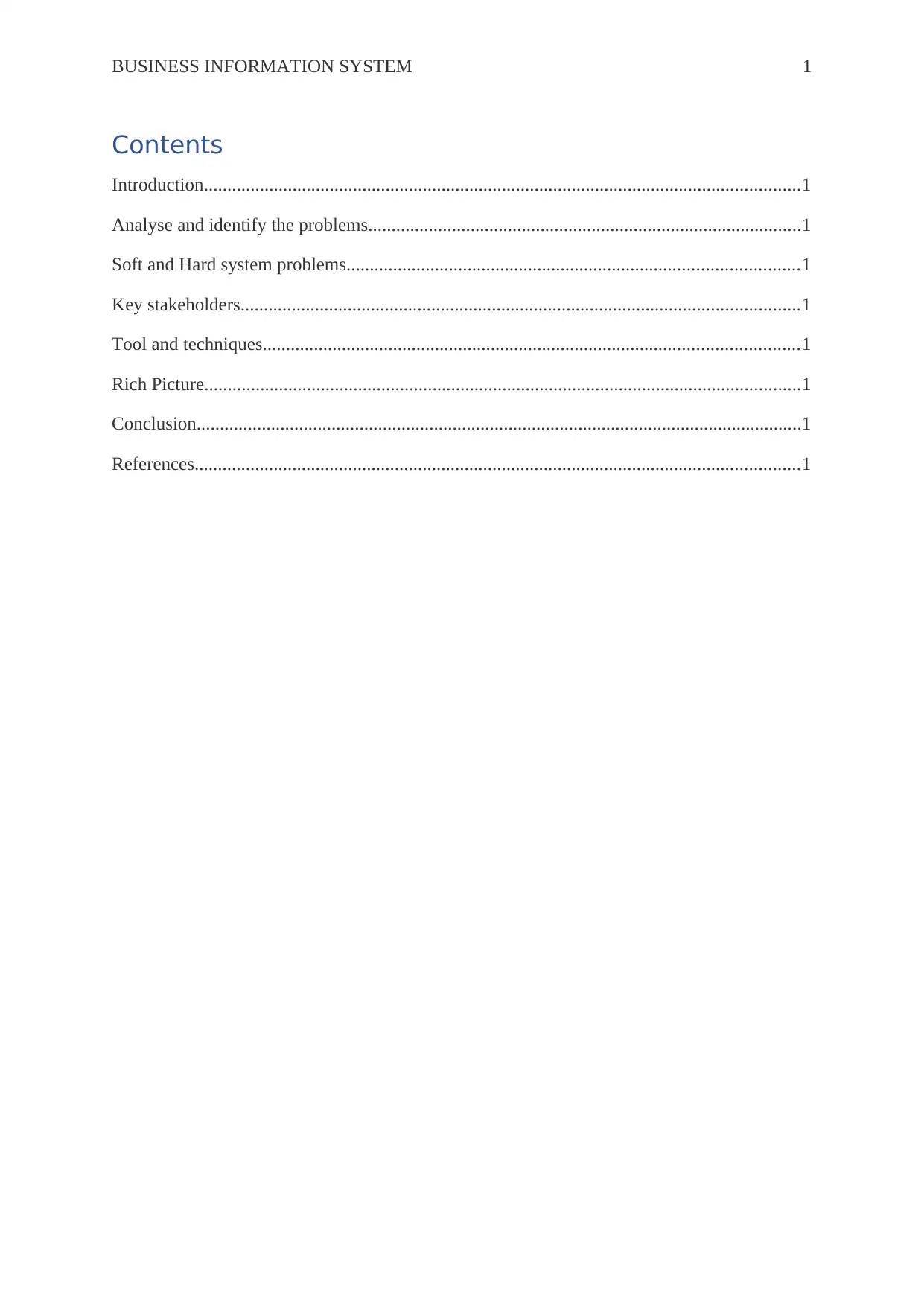
BUSINESS INFORMATION SYSTEM 1
Contents
Introduction................................................................................................................................1
Analyse and identify the problems.............................................................................................1
Soft and Hard system problems.................................................................................................1
Key stakeholders........................................................................................................................1
Tool and techniques...................................................................................................................1
Rich Picture................................................................................................................................1
Conclusion..................................................................................................................................1
References..................................................................................................................................1
Contents
Introduction................................................................................................................................1
Analyse and identify the problems.............................................................................................1
Soft and Hard system problems.................................................................................................1
Key stakeholders........................................................................................................................1
Tool and techniques...................................................................................................................1
Rich Picture................................................................................................................................1
Conclusion..................................................................................................................................1
References..................................................................................................................................1
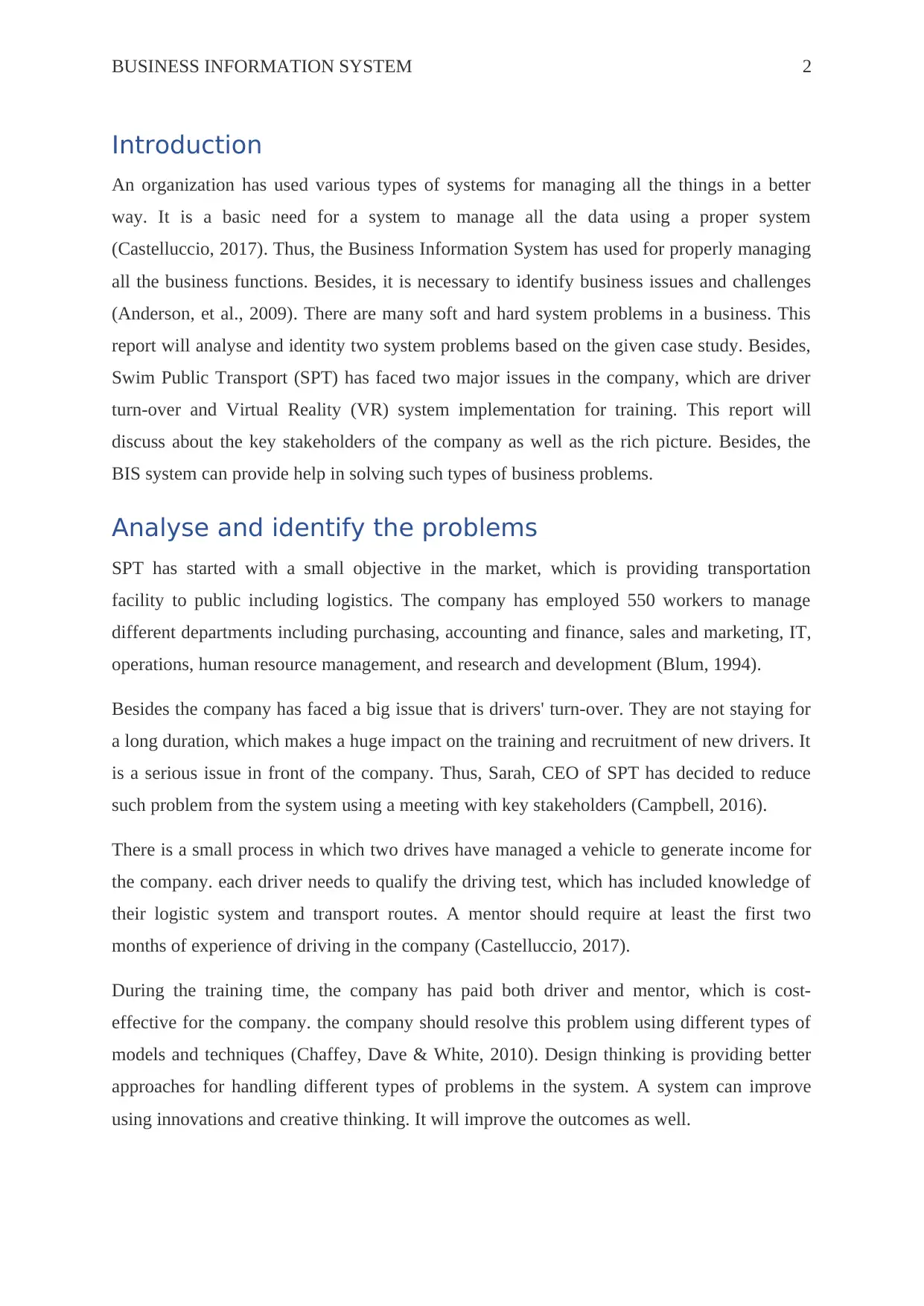
BUSINESS INFORMATION SYSTEM 2
Introduction
An organization has used various types of systems for managing all the things in a better
way. It is a basic need for a system to manage all the data using a proper system
(Castelluccio, 2017). Thus, the Business Information System has used for properly managing
all the business functions. Besides, it is necessary to identify business issues and challenges
(Anderson, et al., 2009). There are many soft and hard system problems in a business. This
report will analyse and identity two system problems based on the given case study. Besides,
Swim Public Transport (SPT) has faced two major issues in the company, which are driver
turn-over and Virtual Reality (VR) system implementation for training. This report will
discuss about the key stakeholders of the company as well as the rich picture. Besides, the
BIS system can provide help in solving such types of business problems.
Analyse and identify the problems
SPT has started with a small objective in the market, which is providing transportation
facility to public including logistics. The company has employed 550 workers to manage
different departments including purchasing, accounting and finance, sales and marketing, IT,
operations, human resource management, and research and development (Blum, 1994).
Besides the company has faced a big issue that is drivers' turn-over. They are not staying for
a long duration, which makes a huge impact on the training and recruitment of new drivers. It
is a serious issue in front of the company. Thus, Sarah, CEO of SPT has decided to reduce
such problem from the system using a meeting with key stakeholders (Campbell, 2016).
There is a small process in which two drives have managed a vehicle to generate income for
the company. each driver needs to qualify the driving test, which has included knowledge of
their logistic system and transport routes. A mentor should require at least the first two
months of experience of driving in the company (Castelluccio, 2017).
During the training time, the company has paid both driver and mentor, which is cost-
effective for the company. the company should resolve this problem using different types of
models and techniques (Chaffey, Dave & White, 2010). Design thinking is providing better
approaches for handling different types of problems in the system. A system can improve
using innovations and creative thinking. It will improve the outcomes as well.
Introduction
An organization has used various types of systems for managing all the things in a better
way. It is a basic need for a system to manage all the data using a proper system
(Castelluccio, 2017). Thus, the Business Information System has used for properly managing
all the business functions. Besides, it is necessary to identify business issues and challenges
(Anderson, et al., 2009). There are many soft and hard system problems in a business. This
report will analyse and identity two system problems based on the given case study. Besides,
Swim Public Transport (SPT) has faced two major issues in the company, which are driver
turn-over and Virtual Reality (VR) system implementation for training. This report will
discuss about the key stakeholders of the company as well as the rich picture. Besides, the
BIS system can provide help in solving such types of business problems.
Analyse and identify the problems
SPT has started with a small objective in the market, which is providing transportation
facility to public including logistics. The company has employed 550 workers to manage
different departments including purchasing, accounting and finance, sales and marketing, IT,
operations, human resource management, and research and development (Blum, 1994).
Besides the company has faced a big issue that is drivers' turn-over. They are not staying for
a long duration, which makes a huge impact on the training and recruitment of new drivers. It
is a serious issue in front of the company. Thus, Sarah, CEO of SPT has decided to reduce
such problem from the system using a meeting with key stakeholders (Campbell, 2016).
There is a small process in which two drives have managed a vehicle to generate income for
the company. each driver needs to qualify the driving test, which has included knowledge of
their logistic system and transport routes. A mentor should require at least the first two
months of experience of driving in the company (Castelluccio, 2017).
During the training time, the company has paid both driver and mentor, which is cost-
effective for the company. the company should resolve this problem using different types of
models and techniques (Chaffey, Dave & White, 2010). Design thinking is providing better
approaches for handling different types of problems in the system. A system can improve
using innovations and creative thinking. It will improve the outcomes as well.
⊘ This is a preview!⊘
Do you want full access?
Subscribe today to unlock all pages.

Trusted by 1+ million students worldwide
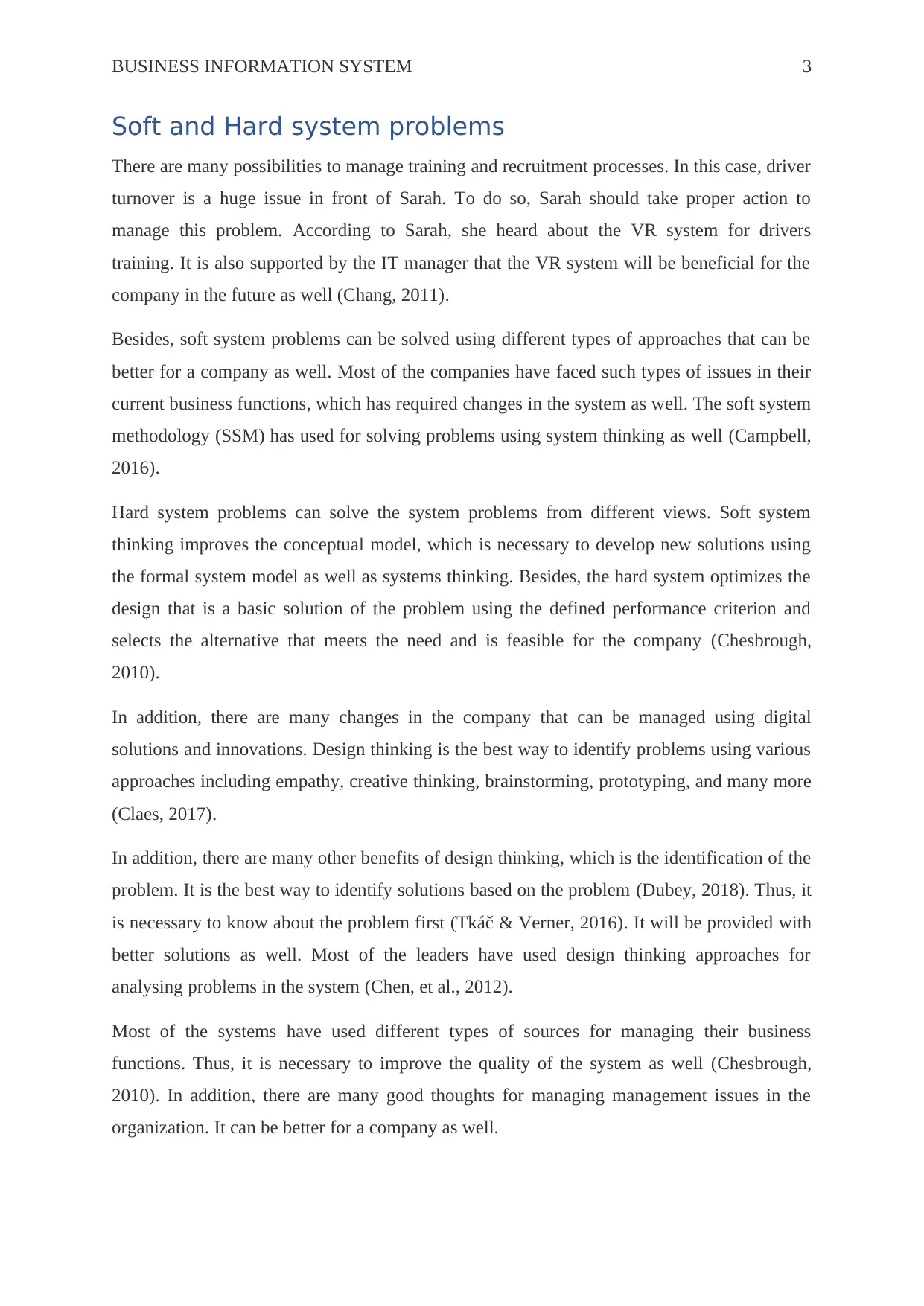
BUSINESS INFORMATION SYSTEM 3
Soft and Hard system problems
There are many possibilities to manage training and recruitment processes. In this case, driver
turnover is a huge issue in front of Sarah. To do so, Sarah should take proper action to
manage this problem. According to Sarah, she heard about the VR system for drivers
training. It is also supported by the IT manager that the VR system will be beneficial for the
company in the future as well (Chang, 2011).
Besides, soft system problems can be solved using different types of approaches that can be
better for a company as well. Most of the companies have faced such types of issues in their
current business functions, which has required changes in the system as well. The soft system
methodology (SSM) has used for solving problems using system thinking as well (Campbell,
2016).
Hard system problems can solve the system problems from different views. Soft system
thinking improves the conceptual model, which is necessary to develop new solutions using
the formal system model as well as systems thinking. Besides, the hard system optimizes the
design that is a basic solution of the problem using the defined performance criterion and
selects the alternative that meets the need and is feasible for the company (Chesbrough,
2010).
In addition, there are many changes in the company that can be managed using digital
solutions and innovations. Design thinking is the best way to identify problems using various
approaches including empathy, creative thinking, brainstorming, prototyping, and many more
(Claes, 2017).
In addition, there are many other benefits of design thinking, which is the identification of the
problem. It is the best way to identify solutions based on the problem (Dubey, 2018). Thus, it
is necessary to know about the problem first (Tkáč & Verner, 2016). It will be provided with
better solutions as well. Most of the leaders have used design thinking approaches for
analysing problems in the system (Chen, et al., 2012).
Most of the systems have used different types of sources for managing their business
functions. Thus, it is necessary to improve the quality of the system as well (Chesbrough,
2010). In addition, there are many good thoughts for managing management issues in the
organization. It can be better for a company as well.
Soft and Hard system problems
There are many possibilities to manage training and recruitment processes. In this case, driver
turnover is a huge issue in front of Sarah. To do so, Sarah should take proper action to
manage this problem. According to Sarah, she heard about the VR system for drivers
training. It is also supported by the IT manager that the VR system will be beneficial for the
company in the future as well (Chang, 2011).
Besides, soft system problems can be solved using different types of approaches that can be
better for a company as well. Most of the companies have faced such types of issues in their
current business functions, which has required changes in the system as well. The soft system
methodology (SSM) has used for solving problems using system thinking as well (Campbell,
2016).
Hard system problems can solve the system problems from different views. Soft system
thinking improves the conceptual model, which is necessary to develop new solutions using
the formal system model as well as systems thinking. Besides, the hard system optimizes the
design that is a basic solution of the problem using the defined performance criterion and
selects the alternative that meets the need and is feasible for the company (Chesbrough,
2010).
In addition, there are many changes in the company that can be managed using digital
solutions and innovations. Design thinking is the best way to identify problems using various
approaches including empathy, creative thinking, brainstorming, prototyping, and many more
(Claes, 2017).
In addition, there are many other benefits of design thinking, which is the identification of the
problem. It is the best way to identify solutions based on the problem (Dubey, 2018). Thus, it
is necessary to know about the problem first (Tkáč & Verner, 2016). It will be provided with
better solutions as well. Most of the leaders have used design thinking approaches for
analysing problems in the system (Chen, et al., 2012).
Most of the systems have used different types of sources for managing their business
functions. Thus, it is necessary to improve the quality of the system as well (Chesbrough,
2010). In addition, there are many good thoughts for managing management issues in the
organization. It can be better for a company as well.
Paraphrase This Document
Need a fresh take? Get an instant paraphrase of this document with our AI Paraphraser
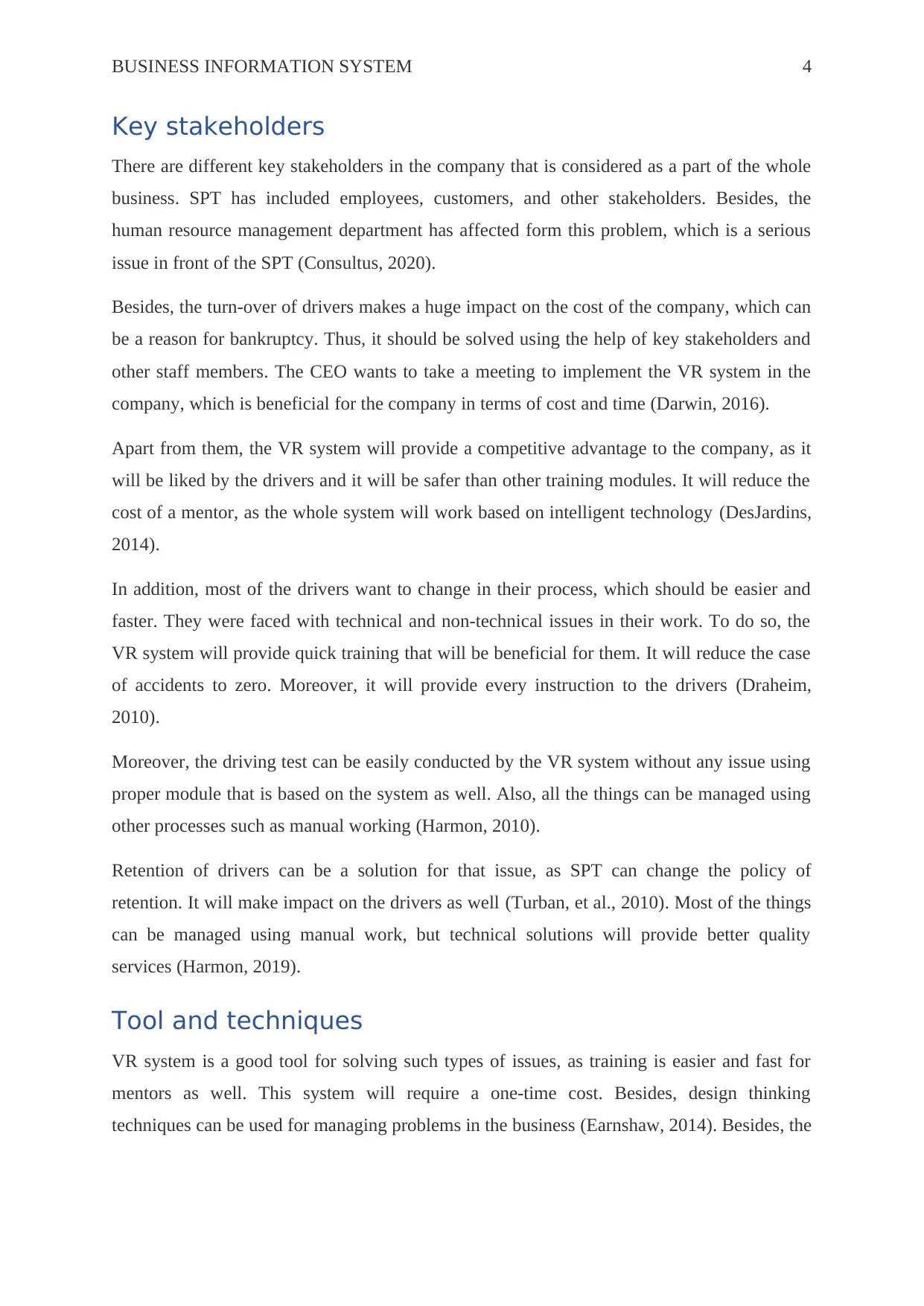
BUSINESS INFORMATION SYSTEM 4
Key stakeholders
There are different key stakeholders in the company that is considered as a part of the whole
business. SPT has included employees, customers, and other stakeholders. Besides, the
human resource management department has affected form this problem, which is a serious
issue in front of the SPT (Consultus, 2020).
Besides, the turn-over of drivers makes a huge impact on the cost of the company, which can
be a reason for bankruptcy. Thus, it should be solved using the help of key stakeholders and
other staff members. The CEO wants to take a meeting to implement the VR system in the
company, which is beneficial for the company in terms of cost and time (Darwin, 2016).
Apart from them, the VR system will provide a competitive advantage to the company, as it
will be liked by the drivers and it will be safer than other training modules. It will reduce the
cost of a mentor, as the whole system will work based on intelligent technology (DesJardins,
2014).
In addition, most of the drivers want to change in their process, which should be easier and
faster. They were faced with technical and non-technical issues in their work. To do so, the
VR system will provide quick training that will be beneficial for them. It will reduce the case
of accidents to zero. Moreover, it will provide every instruction to the drivers (Draheim,
2010).
Moreover, the driving test can be easily conducted by the VR system without any issue using
proper module that is based on the system as well. Also, all the things can be managed using
other processes such as manual working (Harmon, 2010).
Retention of drivers can be a solution for that issue, as SPT can change the policy of
retention. It will make impact on the drivers as well (Turban, et al., 2010). Most of the things
can be managed using manual work, but technical solutions will provide better quality
services (Harmon, 2019).
Tool and techniques
VR system is a good tool for solving such types of issues, as training is easier and fast for
mentors as well. This system will require a one-time cost. Besides, design thinking
techniques can be used for managing problems in the business (Earnshaw, 2014). Besides, the
Key stakeholders
There are different key stakeholders in the company that is considered as a part of the whole
business. SPT has included employees, customers, and other stakeholders. Besides, the
human resource management department has affected form this problem, which is a serious
issue in front of the SPT (Consultus, 2020).
Besides, the turn-over of drivers makes a huge impact on the cost of the company, which can
be a reason for bankruptcy. Thus, it should be solved using the help of key stakeholders and
other staff members. The CEO wants to take a meeting to implement the VR system in the
company, which is beneficial for the company in terms of cost and time (Darwin, 2016).
Apart from them, the VR system will provide a competitive advantage to the company, as it
will be liked by the drivers and it will be safer than other training modules. It will reduce the
cost of a mentor, as the whole system will work based on intelligent technology (DesJardins,
2014).
In addition, most of the drivers want to change in their process, which should be easier and
faster. They were faced with technical and non-technical issues in their work. To do so, the
VR system will provide quick training that will be beneficial for them. It will reduce the case
of accidents to zero. Moreover, it will provide every instruction to the drivers (Draheim,
2010).
Moreover, the driving test can be easily conducted by the VR system without any issue using
proper module that is based on the system as well. Also, all the things can be managed using
other processes such as manual working (Harmon, 2010).
Retention of drivers can be a solution for that issue, as SPT can change the policy of
retention. It will make impact on the drivers as well (Turban, et al., 2010). Most of the things
can be managed using manual work, but technical solutions will provide better quality
services (Harmon, 2019).
Tool and techniques
VR system is a good tool for solving such types of issues, as training is easier and fast for
mentors as well. This system will require a one-time cost. Besides, design thinking
techniques can be used for managing problems in the business (Earnshaw, 2014). Besides, the
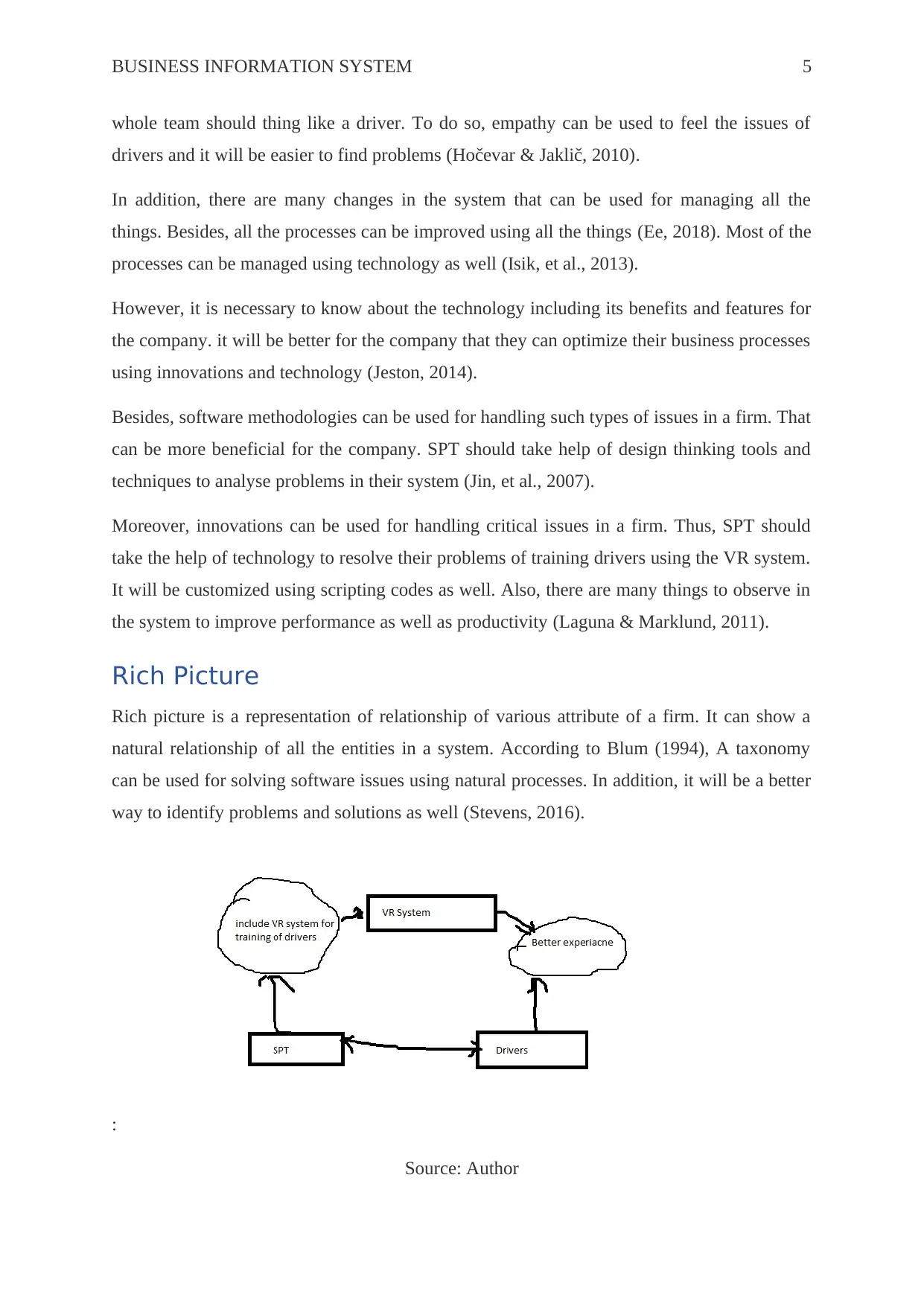
BUSINESS INFORMATION SYSTEM 5
whole team should thing like a driver. To do so, empathy can be used to feel the issues of
drivers and it will be easier to find problems (Hočevar & Jaklič, 2010).
In addition, there are many changes in the system that can be used for managing all the
things. Besides, all the processes can be improved using all the things (Ee, 2018). Most of the
processes can be managed using technology as well (Isik, et al., 2013).
However, it is necessary to know about the technology including its benefits and features for
the company. it will be better for the company that they can optimize their business processes
using innovations and technology (Jeston, 2014).
Besides, software methodologies can be used for handling such types of issues in a firm. That
can be more beneficial for the company. SPT should take help of design thinking tools and
techniques to analyse problems in their system (Jin, et al., 2007).
Moreover, innovations can be used for handling critical issues in a firm. Thus, SPT should
take the help of technology to resolve their problems of training drivers using the VR system.
It will be customized using scripting codes as well. Also, there are many things to observe in
the system to improve performance as well as productivity (Laguna & Marklund, 2011).
Rich Picture
Rich picture is a representation of relationship of various attribute of a firm. It can show a
natural relationship of all the entities in a system. According to Blum (1994), A taxonomy
can be used for solving software issues using natural processes. In addition, it will be a better
way to identify problems and solutions as well (Stevens, 2016).
:
Source: Author
whole team should thing like a driver. To do so, empathy can be used to feel the issues of
drivers and it will be easier to find problems (Hočevar & Jaklič, 2010).
In addition, there are many changes in the system that can be used for managing all the
things. Besides, all the processes can be improved using all the things (Ee, 2018). Most of the
processes can be managed using technology as well (Isik, et al., 2013).
However, it is necessary to know about the technology including its benefits and features for
the company. it will be better for the company that they can optimize their business processes
using innovations and technology (Jeston, 2014).
Besides, software methodologies can be used for handling such types of issues in a firm. That
can be more beneficial for the company. SPT should take help of design thinking tools and
techniques to analyse problems in their system (Jin, et al., 2007).
Moreover, innovations can be used for handling critical issues in a firm. Thus, SPT should
take the help of technology to resolve their problems of training drivers using the VR system.
It will be customized using scripting codes as well. Also, there are many things to observe in
the system to improve performance as well as productivity (Laguna & Marklund, 2011).
Rich Picture
Rich picture is a representation of relationship of various attribute of a firm. It can show a
natural relationship of all the entities in a system. According to Blum (1994), A taxonomy
can be used for solving software issues using natural processes. In addition, it will be a better
way to identify problems and solutions as well (Stevens, 2016).
:
Source: Author
⊘ This is a preview!⊘
Do you want full access?
Subscribe today to unlock all pages.

Trusted by 1+ million students worldwide
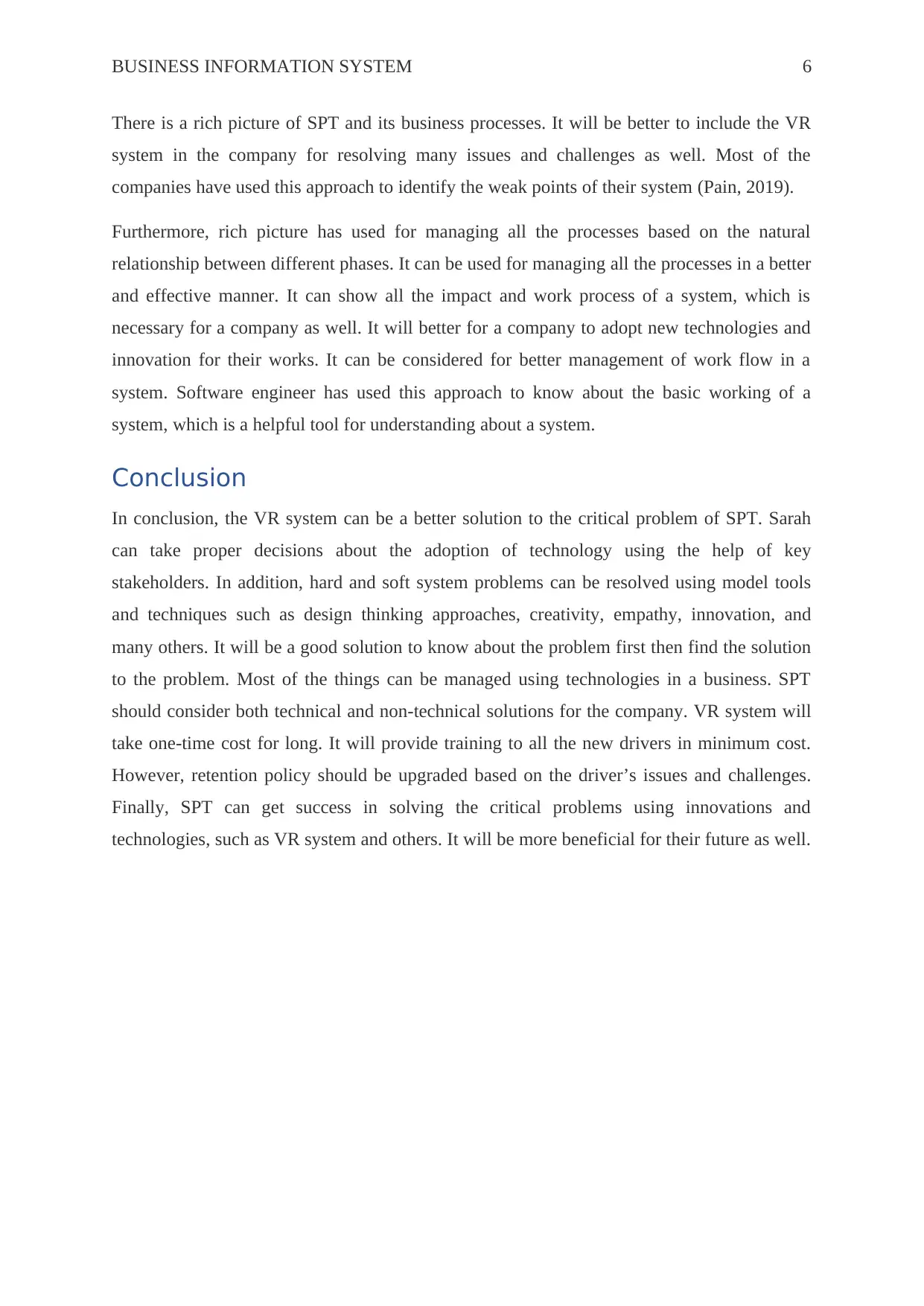
BUSINESS INFORMATION SYSTEM 6
There is a rich picture of SPT and its business processes. It will be better to include the VR
system in the company for resolving many issues and challenges as well. Most of the
companies have used this approach to identify the weak points of their system (Pain, 2019).
Furthermore, rich picture has used for managing all the processes based on the natural
relationship between different phases. It can be used for managing all the processes in a better
and effective manner. It can show all the impact and work process of a system, which is
necessary for a company as well. It will better for a company to adopt new technologies and
innovation for their works. It can be considered for better management of work flow in a
system. Software engineer has used this approach to know about the basic working of a
system, which is a helpful tool for understanding about a system.
Conclusion
In conclusion, the VR system can be a better solution to the critical problem of SPT. Sarah
can take proper decisions about the adoption of technology using the help of key
stakeholders. In addition, hard and soft system problems can be resolved using model tools
and techniques such as design thinking approaches, creativity, empathy, innovation, and
many others. It will be a good solution to know about the problem first then find the solution
to the problem. Most of the things can be managed using technologies in a business. SPT
should consider both technical and non-technical solutions for the company. VR system will
take one-time cost for long. It will provide training to all the new drivers in minimum cost.
However, retention policy should be upgraded based on the driver’s issues and challenges.
Finally, SPT can get success in solving the critical problems using innovations and
technologies, such as VR system and others. It will be more beneficial for their future as well.
There is a rich picture of SPT and its business processes. It will be better to include the VR
system in the company for resolving many issues and challenges as well. Most of the
companies have used this approach to identify the weak points of their system (Pain, 2019).
Furthermore, rich picture has used for managing all the processes based on the natural
relationship between different phases. It can be used for managing all the processes in a better
and effective manner. It can show all the impact and work process of a system, which is
necessary for a company as well. It will better for a company to adopt new technologies and
innovation for their works. It can be considered for better management of work flow in a
system. Software engineer has used this approach to know about the basic working of a
system, which is a helpful tool for understanding about a system.
Conclusion
In conclusion, the VR system can be a better solution to the critical problem of SPT. Sarah
can take proper decisions about the adoption of technology using the help of key
stakeholders. In addition, hard and soft system problems can be resolved using model tools
and techniques such as design thinking approaches, creativity, empathy, innovation, and
many others. It will be a good solution to know about the problem first then find the solution
to the problem. Most of the things can be managed using technologies in a business. SPT
should consider both technical and non-technical solutions for the company. VR system will
take one-time cost for long. It will provide training to all the new drivers in minimum cost.
However, retention policy should be upgraded based on the driver’s issues and challenges.
Finally, SPT can get success in solving the critical problems using innovations and
technologies, such as VR system and others. It will be more beneficial for their future as well.
Paraphrase This Document
Need a fresh take? Get an instant paraphrase of this document with our AI Paraphraser
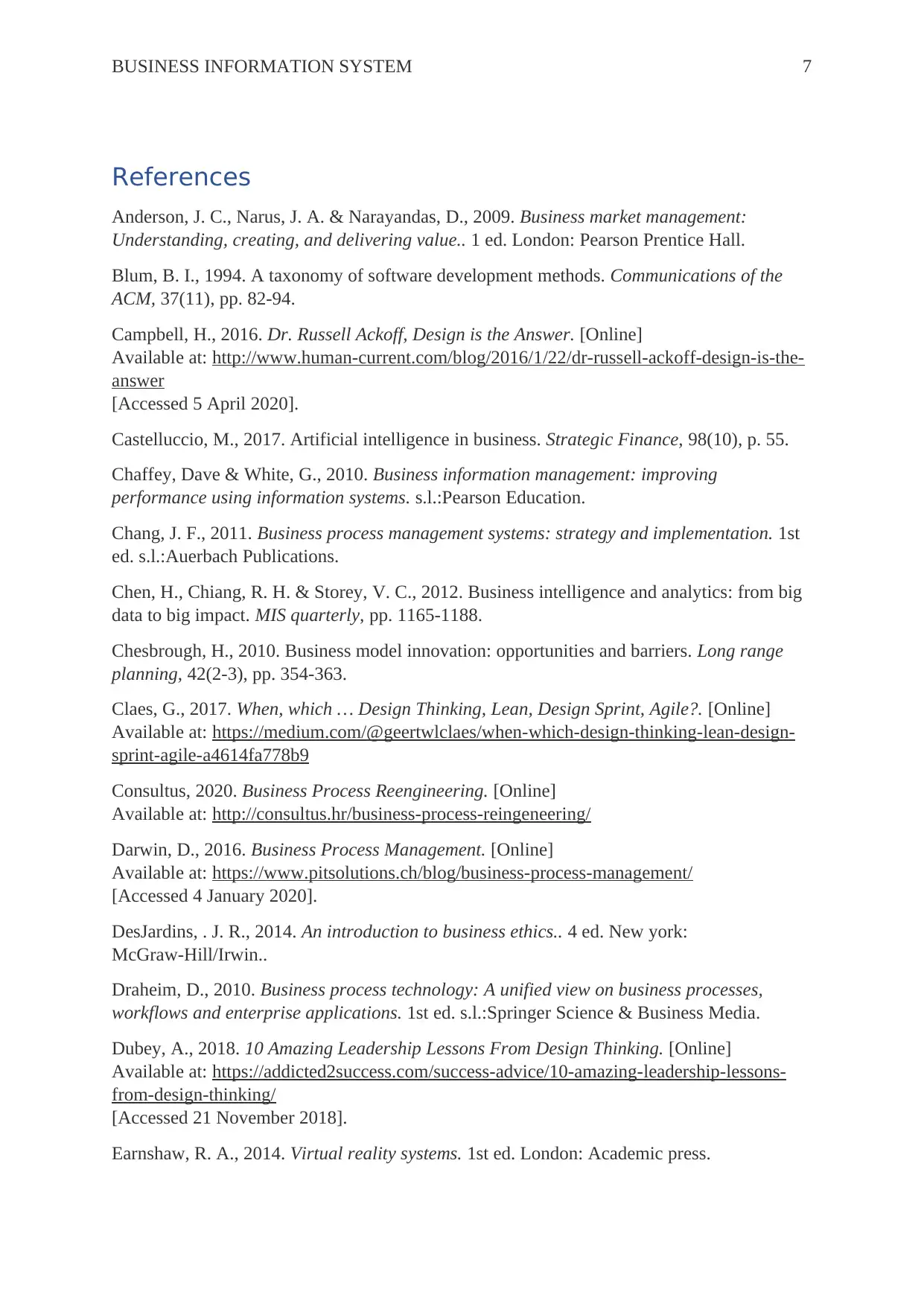
BUSINESS INFORMATION SYSTEM 7
References
Anderson, J. C., Narus, J. A. & Narayandas, D., 2009. Business market management:
Understanding, creating, and delivering value.. 1 ed. London: Pearson Prentice Hall.
Blum, B. I., 1994. A taxonomy of software development methods. Communications of the
ACM, 37(11), pp. 82-94.
Campbell, H., 2016. Dr. Russell Ackoff, Design is the Answer. [Online]
Available at: http://www.human-current.com/blog/2016/1/22/dr-russell-ackoff-design-is-the-
answer
[Accessed 5 April 2020].
Castelluccio, M., 2017. Artificial intelligence in business. Strategic Finance, 98(10), p. 55.
Chaffey, Dave & White, G., 2010. Business information management: improving
performance using information systems. s.l.:Pearson Education.
Chang, J. F., 2011. Business process management systems: strategy and implementation. 1st
ed. s.l.:Auerbach Publications.
Chen, H., Chiang, R. H. & Storey, V. C., 2012. Business intelligence and analytics: from big
data to big impact. MIS quarterly, pp. 1165-1188.
Chesbrough, H., 2010. Business model innovation: opportunities and barriers. Long range
planning, 42(2-3), pp. 354-363.
Claes, G., 2017. When, which … Design Thinking, Lean, Design Sprint, Agile?. [Online]
Available at: https://medium.com/@geertwlclaes/when-which-design-thinking-lean-design-
sprint-agile-a4614fa778b9
Consultus, 2020. Business Process Reengineering. [Online]
Available at: http://consultus.hr/business-process-reingeneering/
Darwin, D., 2016. Business Process Management. [Online]
Available at: https://www.pitsolutions.ch/blog/business-process-management/
[Accessed 4 January 2020].
DesJardins, . J. R., 2014. An introduction to business ethics.. 4 ed. New york:
McGraw-Hill/Irwin..
Draheim, D., 2010. Business process technology: A unified view on business processes,
workflows and enterprise applications. 1st ed. s.l.:Springer Science & Business Media.
Dubey, A., 2018. 10 Amazing Leadership Lessons From Design Thinking. [Online]
Available at: https://addicted2success.com/success-advice/10-amazing-leadership-lessons-
from-design-thinking/
[Accessed 21 November 2018].
Earnshaw, R. A., 2014. Virtual reality systems. 1st ed. London: Academic press.
References
Anderson, J. C., Narus, J. A. & Narayandas, D., 2009. Business market management:
Understanding, creating, and delivering value.. 1 ed. London: Pearson Prentice Hall.
Blum, B. I., 1994. A taxonomy of software development methods. Communications of the
ACM, 37(11), pp. 82-94.
Campbell, H., 2016. Dr. Russell Ackoff, Design is the Answer. [Online]
Available at: http://www.human-current.com/blog/2016/1/22/dr-russell-ackoff-design-is-the-
answer
[Accessed 5 April 2020].
Castelluccio, M., 2017. Artificial intelligence in business. Strategic Finance, 98(10), p. 55.
Chaffey, Dave & White, G., 2010. Business information management: improving
performance using information systems. s.l.:Pearson Education.
Chang, J. F., 2011. Business process management systems: strategy and implementation. 1st
ed. s.l.:Auerbach Publications.
Chen, H., Chiang, R. H. & Storey, V. C., 2012. Business intelligence and analytics: from big
data to big impact. MIS quarterly, pp. 1165-1188.
Chesbrough, H., 2010. Business model innovation: opportunities and barriers. Long range
planning, 42(2-3), pp. 354-363.
Claes, G., 2017. When, which … Design Thinking, Lean, Design Sprint, Agile?. [Online]
Available at: https://medium.com/@geertwlclaes/when-which-design-thinking-lean-design-
sprint-agile-a4614fa778b9
Consultus, 2020. Business Process Reengineering. [Online]
Available at: http://consultus.hr/business-process-reingeneering/
Darwin, D., 2016. Business Process Management. [Online]
Available at: https://www.pitsolutions.ch/blog/business-process-management/
[Accessed 4 January 2020].
DesJardins, . J. R., 2014. An introduction to business ethics.. 4 ed. New york:
McGraw-Hill/Irwin..
Draheim, D., 2010. Business process technology: A unified view on business processes,
workflows and enterprise applications. 1st ed. s.l.:Springer Science & Business Media.
Dubey, A., 2018. 10 Amazing Leadership Lessons From Design Thinking. [Online]
Available at: https://addicted2success.com/success-advice/10-amazing-leadership-lessons-
from-design-thinking/
[Accessed 21 November 2018].
Earnshaw, R. A., 2014. Virtual reality systems. 1st ed. London: Academic press.
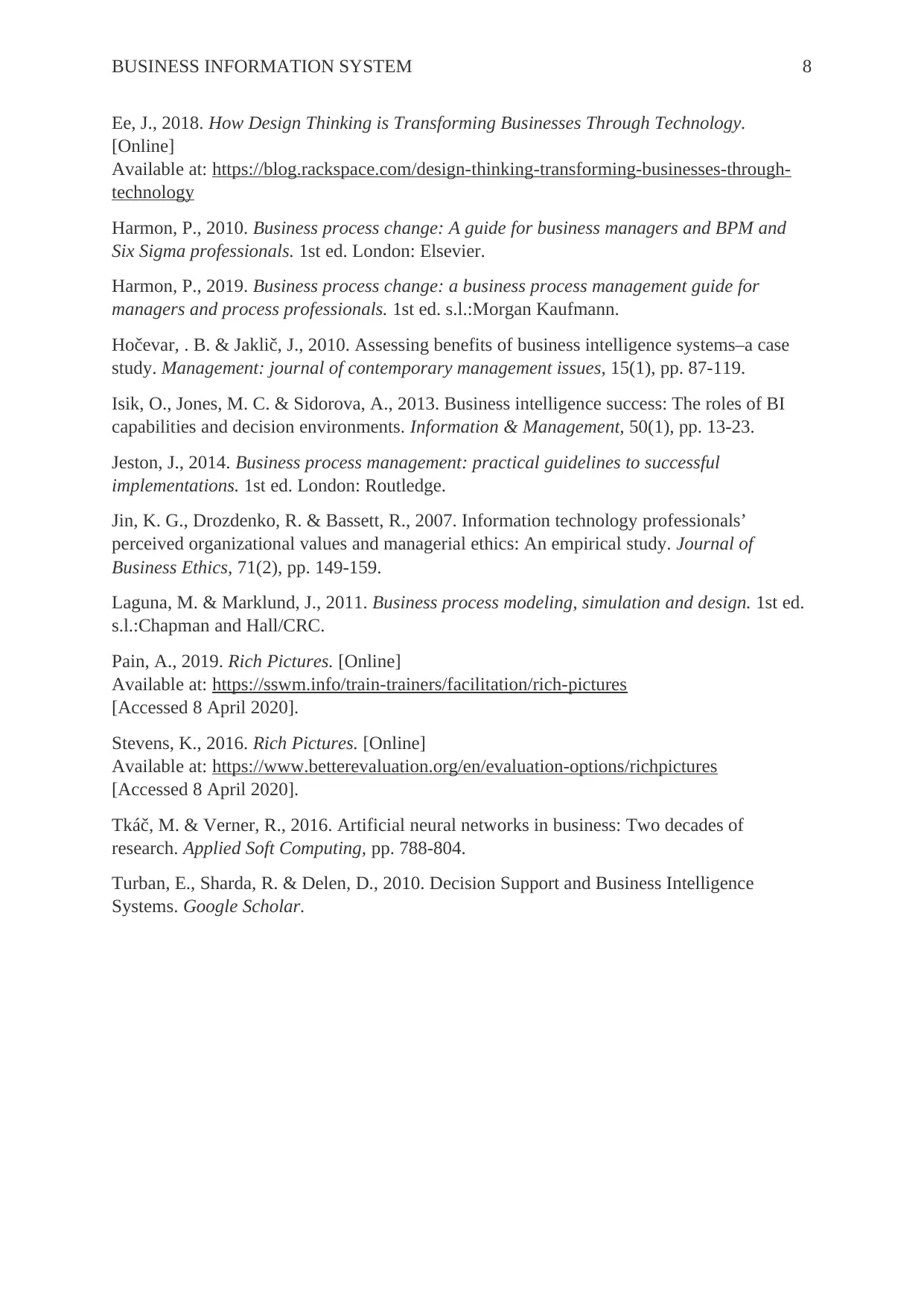
BUSINESS INFORMATION SYSTEM 8
Ee, J., 2018. How Design Thinking is Transforming Businesses Through Technology.
[Online]
Available at: https://blog.rackspace.com/design-thinking-transforming-businesses-through-
technology
Harmon, P., 2010. Business process change: A guide for business managers and BPM and
Six Sigma professionals. 1st ed. London: Elsevier.
Harmon, P., 2019. Business process change: a business process management guide for
managers and process professionals. 1st ed. s.l.:Morgan Kaufmann.
Hočevar, . B. & Jaklič, J., 2010. Assessing benefits of business intelligence systems–a case
study. Management: journal of contemporary management issues, 15(1), pp. 87-119.
Isik, O., Jones, M. C. & Sidorova, A., 2013. Business intelligence success: The roles of BI
capabilities and decision environments. Information & Management, 50(1), pp. 13-23.
Jeston, J., 2014. Business process management: practical guidelines to successful
implementations. 1st ed. London: Routledge.
Jin, K. G., Drozdenko, R. & Bassett, R., 2007. Information technology professionals’
perceived organizational values and managerial ethics: An empirical study. Journal of
Business Ethics, 71(2), pp. 149-159.
Laguna, M. & Marklund, J., 2011. Business process modeling, simulation and design. 1st ed.
s.l.:Chapman and Hall/CRC.
Pain, A., 2019. Rich Pictures. [Online]
Available at: https://sswm.info/train-trainers/facilitation/rich-pictures
[Accessed 8 April 2020].
Stevens, K., 2016. Rich Pictures. [Online]
Available at: https://www.betterevaluation.org/en/evaluation-options/richpictures
[Accessed 8 April 2020].
Tkáč, M. & Verner, R., 2016. Artificial neural networks in business: Two decades of
research. Applied Soft Computing, pp. 788-804.
Turban, E., Sharda, R. & Delen, D., 2010. Decision Support and Business Intelligence
Systems. Google Scholar.
Ee, J., 2018. How Design Thinking is Transforming Businesses Through Technology.
[Online]
Available at: https://blog.rackspace.com/design-thinking-transforming-businesses-through-
technology
Harmon, P., 2010. Business process change: A guide for business managers and BPM and
Six Sigma professionals. 1st ed. London: Elsevier.
Harmon, P., 2019. Business process change: a business process management guide for
managers and process professionals. 1st ed. s.l.:Morgan Kaufmann.
Hočevar, . B. & Jaklič, J., 2010. Assessing benefits of business intelligence systems–a case
study. Management: journal of contemporary management issues, 15(1), pp. 87-119.
Isik, O., Jones, M. C. & Sidorova, A., 2013. Business intelligence success: The roles of BI
capabilities and decision environments. Information & Management, 50(1), pp. 13-23.
Jeston, J., 2014. Business process management: practical guidelines to successful
implementations. 1st ed. London: Routledge.
Jin, K. G., Drozdenko, R. & Bassett, R., 2007. Information technology professionals’
perceived organizational values and managerial ethics: An empirical study. Journal of
Business Ethics, 71(2), pp. 149-159.
Laguna, M. & Marklund, J., 2011. Business process modeling, simulation and design. 1st ed.
s.l.:Chapman and Hall/CRC.
Pain, A., 2019. Rich Pictures. [Online]
Available at: https://sswm.info/train-trainers/facilitation/rich-pictures
[Accessed 8 April 2020].
Stevens, K., 2016. Rich Pictures. [Online]
Available at: https://www.betterevaluation.org/en/evaluation-options/richpictures
[Accessed 8 April 2020].
Tkáč, M. & Verner, R., 2016. Artificial neural networks in business: Two decades of
research. Applied Soft Computing, pp. 788-804.
Turban, E., Sharda, R. & Delen, D., 2010. Decision Support and Business Intelligence
Systems. Google Scholar.
⊘ This is a preview!⊘
Do you want full access?
Subscribe today to unlock all pages.

Trusted by 1+ million students worldwide
1 out of 9
Related Documents
Your All-in-One AI-Powered Toolkit for Academic Success.
+13062052269
info@desklib.com
Available 24*7 on WhatsApp / Email
![[object Object]](/_next/static/media/star-bottom.7253800d.svg)
Unlock your academic potential
Copyright © 2020–2025 A2Z Services. All Rights Reserved. Developed and managed by ZUCOL.





